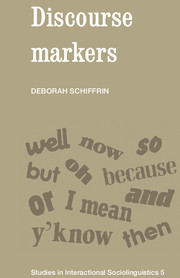Book contents
- Frontmatter
- Contents
- Acknowledgements
- Intonation and transcription conventions
- 1 Background: What is discourse?
- 2 Prelude to analysis: Definitions and data
- 3 Questions: Why analyze discourse markers?
- 4 Oh: Marker of information management
- 5 Well: Marker of response
- 6 Discourse connectives: and, but, or
- 7 So and because: Markers of cause and result
- 8 Temporal adverbs: now and then
- 9 Information and participation: y'know and I mean
- 10 Discourse markers: Contextual coordinates of talk
- Notes
- References
- Author index
- Subject index
8 - Temporal adverbs: now and then
Published online by Cambridge University Press: 05 June 2012
- Frontmatter
- Contents
- Acknowledgements
- Intonation and transcription conventions
- 1 Background: What is discourse?
- 2 Prelude to analysis: Definitions and data
- 3 Questions: Why analyze discourse markers?
- 4 Oh: Marker of information management
- 5 Well: Marker of response
- 6 Discourse connectives: and, but, or
- 7 So and because: Markers of cause and result
- 8 Temporal adverbs: now and then
- 9 Information and participation: y'know and I mean
- 10 Discourse markers: Contextual coordinates of talk
- Notes
- References
- Author index
- Subject index
Summary
Thus far, we have examined markers which either have no lexical meaning (oh, well) or whose semantic meaning influences their use on non-ideational discourse planes (and, but, or, so, because). I turn now to two markers whose deictic meaning influences their use on several different discourse planes.
Deictic elements relate an utterance to its person, space, and time coordinates. Now and then are time deictics because they convey a relationship between the time at which a proposition is assumed to be true, and the time at which it is presented in an utterance. In other words, now and then are deictic because their meaning depends on a parameter of the speech situation (time of speaking).
I will use the term reference time to refer to the deictic relationship between a proposition and its speaking time, i.e. the time of its utterance (Jakobson 1957). For example, (1a) and (1b) present the same propositional content:
(1) a. Sue teaches linguistics now.
b. Sue taught linguistics then.
They have different reference times, however, because they establish different time periods, relative to the speaking time, during which Sue's teaching linguistics is assumed to be true: in (1a), it is true during a period overlapping with the speaking time; in (1b), it is true during a period prior to the speaking time. This difference is indicated not only by the shift from present to preterit tense, but by the time adverbs now and then.
- Type
- Chapter
- Information
- Discourse Markers , pp. 228 - 266Publisher: Cambridge University PressPrint publication year: 1987
- 1
- Cited by



